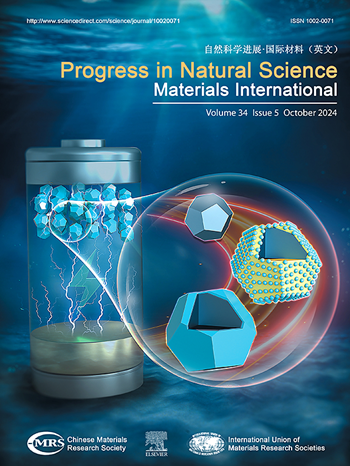用于高级绝热应用的柔性zr基陶瓷纤维的高效解决方案吹丝
IF 7.1
2区 材料科学
Q2 MATERIALS SCIENCE, MULTIDISCIPLINARY
Progress in Natural Science: Materials International
Pub Date : 2024-12-01
DOI:10.1016/j.pnsc.2024.10.010
引用次数: 0
摘要
弹性锆基陶瓷纤维产品因其卓越的耐高温性能而备受关注。然而,商品化的高性能锆基纤维仍然难以获得,这阻碍了其在隔热领域的广泛应用。本文通过溶液吹塑纺丝技术实现了各种锆基(ZrO2、ZrSiO4)陶瓷纤维的大规模制造,该技术具有成本效益高、生产效率高、能耗低和产品质量优异等优点。通过 1000 °C 的高温烧结,吹纺有机纤维可转化为直径为 0.5 至 2 μm 的锆基陶瓷纤维。通过高温热解工艺优化这些纤维的结晶结构,提高了它们的耐热性。此外,通过引入聚硅氧烷作为硅源,合成的 ZrSiO4 纤维的机械性能和耐高温性能也得到了显著改善。这些吹纺 Zr 基海绵纤维具有良好的内部孔隙结构、高温弹性和隔热性能。本文章由计算机程序翻译,如有差异,请以英文原文为准。
High-efficiency solution blow spinning of flexible Zr-based ceramic fibers for advanced thermal insulation applications
Elastic zirconium-based ceramic fiber products have gain particular interest due to their exceptional high-temperature resistant performance. Nonetheless, commercial high-performance Zr-based fibers are still difficult to acquire which hinders its widely application in thermal insulation scenes. Herein, large-scale fabrication of various Zr-based (ZrO2, ZrSiO4) ceramic fibers were achieved through solution blow spinning technology, which was endowed with merits such as cost-effectiveness, high production efficiency, reduced energy consumption, and exceptional product quality. Through high-temperature sintering to 1000 °C, blow spun organic fibers can be converted into Zr-based ceramic fibers with diameters ranging from 0.5 to 2 μm. Optimizing the crystalline structure of these fibers through high-temperature pyrolysis process enhanced their thermal resistance. Additionally, through introducing polysiloxane as the Si source, ZrSiO4 fibers can be synthesized with markedly improved mechanical properties and high-temperature resistance. These blow-spun Zr-based fiber sponges exhibit advantageous internal pore structures, high-temperature elasticity and thermal insulation performance.
求助全文
通过发布文献求助,成功后即可免费获取论文全文。
去求助
来源期刊
CiteScore
8.60
自引率
2.10%
发文量
2812
审稿时长
49 days
期刊介绍:
Progress in Natural Science: Materials International provides scientists and engineers throughout the world with a central vehicle for the exchange and dissemination of basic theoretical studies and applied research of advanced materials. The emphasis is placed on original research, both analytical and experimental, which is of permanent interest to engineers and scientists, covering all aspects of new materials and technologies, such as, energy and environmental materials; advanced structural materials; advanced transportation materials, functional and electronic materials; nano-scale and amorphous materials; health and biological materials; materials modeling and simulation; materials characterization; and so on. The latest research achievements and innovative papers in basic theoretical studies and applied research of material science will be carefully selected and promptly reported. Thus, the aim of this Journal is to serve the global materials science and technology community with the latest research findings.
As a service to readers, an international bibliography of recent publications in advanced materials is published bimonthly.

 求助内容:
求助内容: 应助结果提醒方式:
应助结果提醒方式:


